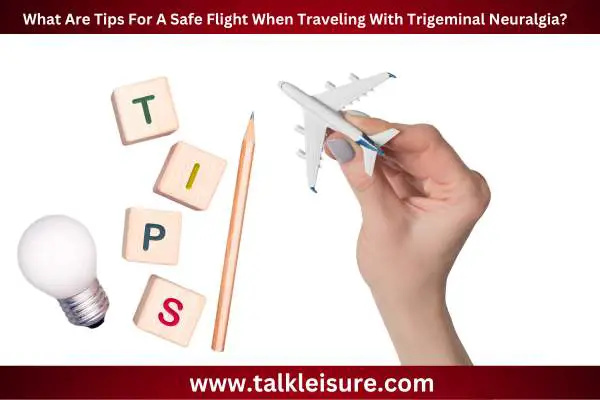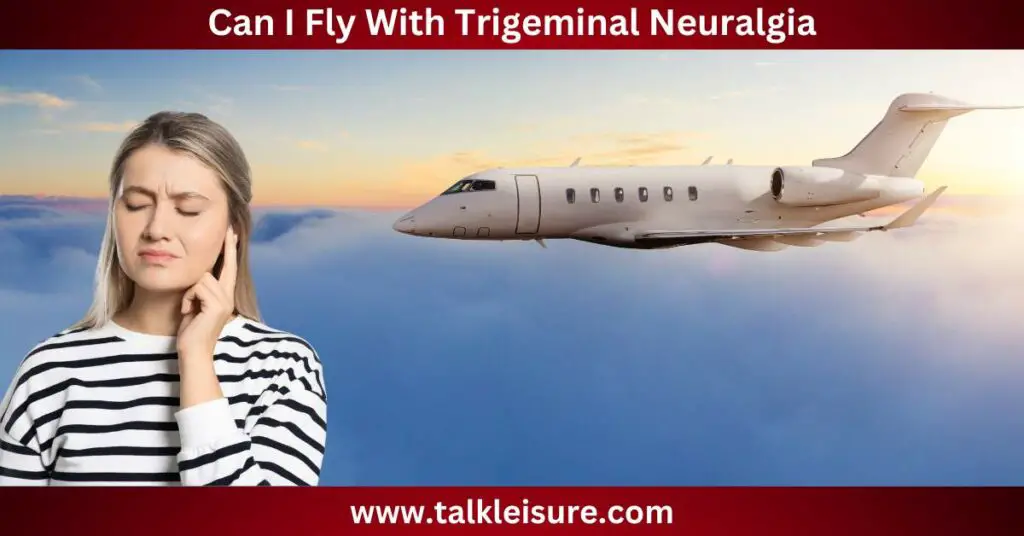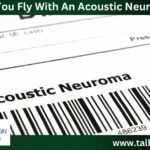Have you ever wondered if you can travel by plane with trigeminal neuralgia?
This neurological condition affects the trigeminal nerve, causing severe facial pain that can make daily activities challenging.
As a result, you may be concerned about the impact flying may have on your condition.
In this blog, we’ll explore whether it’s safe for sufferers of trigeminal neuralgia to fly and provide tips for making air travel as comfortable as possible.
So, put your seatbelt on, ensure your tray table is locked and upright, and let’s prepare for takeoff!
Can I Fly With Trigeminal Neuralgia?
This is a question that many people with this condition have asked themselves.
Trigeminal Neuralgia is a neurological condition that causes severe pain in the face.
Whether flying with TN is possible or not depends on the individual and their particular experience with the condition.
Some TN sufferers have reported pain flare-ups during flights, while others have not experienced any issues.
It is important to consult with a doctor and take necessary precautions, such as medication and avoiding triggers, before deciding to fly.
Knowing individual limitations and being prepared can help ensure a safe and comfortable travel experience for those with trigeminal neuralgia.
What Is Trigeminal Neuralgia?

Myelin breakdown, combined with any touch or stimulation, causes excruciating pain on the corresponding side of the face.
It is described as one of the most painful conditions known to mankind.
TN can be triggered by anything, from a cool breeze to eating or breathing.
Those with TN can have attacks that last from 45 minutes to over three hours.
The condition often leads to seeking medical help, including trips to see specialists and undergo surgery.
Despite the challenges, those with TN can travel and enjoy life with proper management and precautions.
What Are The Causes Of Developing Trigeminal Neuralgia?

Trigeminal neuralgia is a rare condition characterized by sudden, severe facial pain.
The condition is caused by trigeminal nerve compression, which transmits pain and touch sensations from the face, teeth, and mouth to the brain.
In most cases, the compression is caused by a nearby blood vessel pressing on the part of the nerve inside the skull.
However, in rare cases, the condition can occur due to damage to the trigeminal nerve caused by an underlying condition such as multiple sclerosis or a tumor.
The condition tends to be overdiagnosed by doctors, often affects women more than men, and is rare in people under 40.
Can I Fly With Trigeminal Neuralgia

Flying with trigeminal neuralgia may be a challenge for some individuals.
For those with the condition, vibrations from the airplane’s engines can trigger electric-like shocks and excruciating pain in the face’s teeth, gums, and cheek areas.
However, with proper medication and pain management, many people with trigeminal neuralgia can fly without difficulty.
It is important to consult with a doctor before flying and to take medication regularly and as prescribed.
Not only patients with TN those who have POTS Syndrome and other health issues must check whether it is safe to fly.
Some individuals may also minimize exposure to triggers by avoiding long drives and opting to fly instead.
Individuals with trigeminal neuralgia can still enjoy travel and adventure with careful planning and preparation.
Can I Fly With Trigeminal Neuralgia For Medication

People with trigeminal neuralgia may wonder if they can fly with this condition, especially if they need to travel for medical reasons.
According to forums and personal experiences from trigeminal neuralgia patients, flying may trigger pain due to the vibrations from the engine.
However, medication can help reduce the chances of an episode occurring during the flight.
The recommended medications for trigeminal neuralgia include carbamazepine, oxycarbazepine, and gabapentin.
It is crucial to persevere with the medication and take it religiously.
It is advisable to set an alarm on the phone to remind oneself when it’s due.
It is often unavoidable if you are planning to fly for medication.
Traveling with trigeminal neuralgia may be challenging, but flying with the proper medication is possible.
Where To Fly With Trigeminal Neuralgia
When dealing with trigeminal neuralgia, it’s important to consider potential triggers and plan accordingly.
Flying may concern some individuals, as the engine’s vibrations and pressure changes can trigger attacks.
However, some individuals with trigeminal neuralgia have successfully flown with the condition.
Talking to a doctor about medication options and managing symptoms while flying may be helpful.
When choosing a destination, it may be beneficial to consider options with easy access to medical care, such as cities with hospitals or clinics that have experience treating trigeminal neuralgia.
Additionally, destinations with a more relaxed pace and accessible accommodations may be helpful for those with chronic pain.
Can Vibration From Flights trigger Trigeminal Neuralgia?

According to some sources, trigeminal neuralgia (TN) can be triggered by vibrations from flights.
This could be why some individuals experience pain during air travel.
However, for some people with TN, there are no identifiable triggers.
TN is described as one of the most painful conditions known to mankind and occurs when there is flawed myelin in one or both of the trigeminal nerves that provide sensation to the face.
Any stimulation, no matter how slight, like a cool breeze, touch, or kiss on that side of the face, can trigger an excruciating pain attack.
Traveling with TN can be challenging, especially when seeking treatment from doctors.
What Are The Challenges Of Flying With Trigeminal Neuralgia

Flying with trigeminal neuralgia can be extremely challenging due to the pain and sensitivity triggered by the pressure changes during flights.
The vibrations and movements felt during takeoff, landing, and turbulence can also worsen the symptoms and cause discomfort.
For some people, even the slightest touch or cool breeze can trigger an attack, making it difficult to endure long flights.
The medication taken for TN can cause side effects and may require frequent adjustments, which could impact the ability to fly.
It is essential to consult with a healthcare provider and seek advice on suitable measures to take while flying to minimize the risks and discomfort caused by trigeminal neuralgia.
What Are Tips For A Safe Flight When Traveling With Trigeminal Neuralgia?

When traveling by air with trigeminal neuralgia, it is important to take extra precautions to ensure a safe and comfortable flight.
Before departing, it is crucial to pack all necessary medication and bring a copy of the prescription in case of any issues at airport security.
It is also recommended to bring an extra supply of medication in case of unexpected travel delays.
During the flight, it may be helpful to use noise-canceling headphones or earplugs to minimize potential triggers, such as airplane noise.
It is also important to remain hydrated by drinking plenty of water and avoiding alcohol and caffeine.
Taking stretch breaks and walking up and down the aisle can also help prevent discomfort and promote circulation.
Planning ahead and being mindful of triggers can help ensure a safe and enjoyable flight.
What Are The Treatment Options For Trigeminal Neuralgia While Traveling?
Treatment for trigeminal neuralgia while traveling is important to consider for those with this condition.
It is recommended to research multiple medical facilities in the area and pack all necessary medications and equipment.
A copy of medical records and contact information for healthcare providers are also advised.
Reusable heat and ice packs can provide quick relief during flights or car rides.
For those who maintain routine medications, it is important to ensure they are taken as needed while traveling.
It may also be beneficial to inform the airline of medical conditions and request assistance during the flight.
It is better to avoid drugs like Valium even if you are flying with flight phobia, as this may not be suitable for those with trigeminal neuralgia.
Overall, prioritizing health and safety measures can help alleviate symptoms and make traveling with trigeminal neuralgia more manageable.
What Are Things To Avoid When Flying With Trigeminal Neuralgia?
When flying with trigeminal neuralgia, there are certain things to avoid to prevent triggering an attack.
It is important to avoid exposure to air conditioning on the plane, temperature changes, and pressure changes during take-off and landing.
Additionally, one should avoid cold drinks, restaurants, and breezy areas that may cause discomfort.
It is also important to take medication regularly, accounting for any time differences when traveling to a different time zone.
Lastly, one should not let the stress of traveling worsen symptoms and should take time to rest and relax when needed.
In case, if a person with trigeminal neuralgia also has other health issues like seizures then address it to you doctor when making travel plans.
Seizures occur due to electrical activity bursts in the brain. Seizure can be triggered during air travel due to flight apprehension.
Therefore, it is best to check on your overall health condition before flying.
Is There Any Real-life Experiences Of Flying With Trigeminal Neuralgia

There are real-life experiences with flying with trigeminal neuralgia (TN).
Patients have reported that the engine vibrations and pressure changes during a flight can trigger electric shocks, excruciating gum and teeth pain, and tingling in their faces.
Some have also shared their journeys seeking treatment in different cities and countries.
While medication can help manage the symptoms, taking it religiously and setting reminders is crucial.
It’s important to note that each patient’s experience with TN is unique and unpredictable. It would be wise to consult a doctor before booking a flight and to plan accordingly.
Bottom Line
The bottom line on whether one can fly with trigeminal neuralgia is that it is possible but requires careful preparation and planning.
Speaking with a physician beforehand is important, as is bringing all necessary medications and prescriptions in a clearly labeled container.
Packaging extra medication and bringing a doctor’s note explaining the condition and the need for certain accommodations are also advised.
Additionally, it is important to be aware of potential triggers, such as temperature and air pressure changes, and to avoid them.
With proper preparation, individuals with trigeminal neuralgia can still enjoy travel benefits.
For more interesting information on safe flights, check our recent blog, “Can you fly with creatine.”
FAQs
Can Flying Make Trigeminal Neuralgia Worse?
Yes, for some people with trigeminal neuralgia, flying can be a trigger due to the vibrations from the engines and other sources on the plane.
Taking medication that a doctor has prescribed can help you manage symptoms while flying. It may also be helpful to sit away from the engines or wheels and use earplugs to minimize vibrations.
In Which Area Does Trigeminal Neuralgia Trigger Most Pain?
Trigeminal neuralgia is one of the most painful conditions known to mankind. It is caused by the breakdown of myelin on one or both of the facial nerve glands, resulting in excruciating pain on the corresponding side of the face.
The trigeminal nerve provides facial sensation, including on the forehead, cheeks, nose, upper lip, and lower lip.
Therefore, trigeminal neuralgia can cause pain in any of these areas.
Can I Do Physiotherapy For Trigeminal Neuralgia?
Trigeminal neuralgia is a rare neurological disease that causes severe facial pain. Patients often wonder if they can do physiotherapy for trigeminal neuralgia.
Physiotherapy is recommended for patients with trigeminal neuralgia. As trigeminal nerve compression causes the condition, physiotherapy could potentially help reduce the pain.












